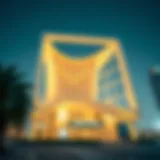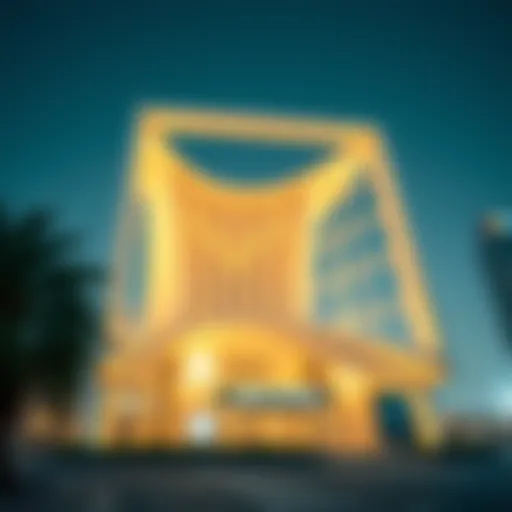Understanding Wadi Habb: Geography and Culture
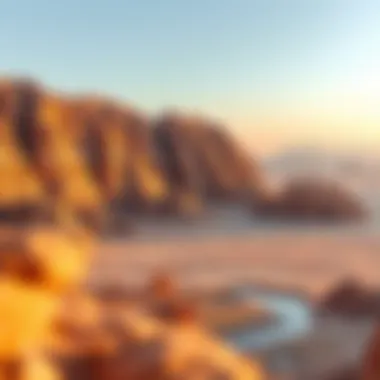

Intro
Wadi Habb, nestled in the vibrant landscape of the UAE, is not just a geographical feature but a testament to the region's rich history and ecological diversity. With its unique charm, this wadi stands as a confluence of historical significance and contemporary urban development. For investors, homebuyers, agents, and analysts alike, a comprehensive understanding of Wadi Habb extends beyond mere environmental interest; it delves into the fabric of cultural heritage and economic potential that the area embodies.
In this exploration, we will dissect the multifaceted aspects of Wadi Habb, examining its ecological importance, historical relevance, and how these elements impact current real estate trends. Here, we present a thorough discourse tailored for those keen on understanding both the past and the future of this dynamic area. From the biodiversity that flourishes within its confines to the architectural innovations framing its vicinity, we will navigate through a landscape that is as much about nature as it is about urban progression.
Market Trends
As we pivot towards the real estate facets of Wadi Habb, it is imperative to grasp the current market dynamics that shape this area. Investors and potential buyers must consider several key trends as they venture into this evolving landscape.
Current Market Analysis
The demand for properties around Wadi Habb has witnessed a steady uptick in recent years, as various demographic groups show an increasing inclination to either invest or reside in regions that offer both nature and modern amenities.
- Rising Popularity: Areas adjacent to Wadi Habb are becoming appealing destinations due to their proximity to urban centers, yet they retain a sense of tranquility often lost in more urbanized spaces.
- Investment Opportunities: The real estate market here is becoming a hotspot for investors looking for high returns, fueled by the UAE's ongoing push towards integrating green spaces into urban development.
- Pricing Trends: Current property prices in the vicinity are competitive, reflecting both the natural beauty of the landscape and the infrastructural advancements taking place.
Future Projections
Looking ahead, projections for Wadi Habb’s real estate market seem optimistic.
- The enhancement of public transportation links is anticipated to further bolster interest among buyers and developers.
- Integrative urban planning initiatives that include environmental conservation are likely to resonate with eco-conscious investors.
- Demand for vacation properties and short-term rentals is expected to rise, as tourism and eco-tourism gain traction in the region.
"Investing in Wadi Habb is not just about buying property; it is about being a part of a sustainable and culturally rich environment that is on the brink of rapid growth."
Property Insights
In-depth knowledge of property types and neighborhood comparisons is essential for making informed decisions in Wadi Habb's market.
Neighborhood Comparisons
Adjacent neighborhoods showcase varying character and appeal:
- Al Ain Road Area: Known for its luxury villas and family-oriented communities, this area is perfect for those looking for spacious living while staying close to natural attractions.
- Central Wadi Habb: This zone combines modern living with stunning views of the wadi, making it attractive for both permanent residents and short-stay tourists.
- Emerging Developments: Innovative projects are sprouting, promoting sustainability and community living; these neighborhoods are likely to become increasingly popular over the next decade.
Property Types Explained
Understanding the different types of properties available is key to navigating the market:
- Villas: Often located in family-centric neighborhoods, offering large spaces and outdoor areas, appealing to those seeking comfort and privacy.
- Condos/Apartments: High-rise buildings present in the central areas appeal to young professionals and investors due to their accessibility and modern facility offerings.
- Eco-friendly Houses: Increasingly popular, these homes feature energy-efficient designs and integrate seamlessly into the natural landscape, attracting environmentally conscious buyers.
Through this exploration of Wadi Habb’s market trends and property insights, stakeholders can better strategize their investments and understand the shifting dynamics that define this unique region in the UAE. For more details and continuous updates on Wadi Habb, consider following resources like Wikipedia and real estate platforms specializing in UAE listings.
Foreword to Wadi Habb
Wadi Habb is more than just a beautiful landscape; it captivates those who are willing to dive deeper into its essence. This introduction sets the tone for an exploration that unveils the area's geographical significance and cultural richness, both pivotal in understanding its role within the broader context of the UAE. For investors, homebuyers, and professionals in real estate, a comprehensive understanding of Wadi Habb can unlock numerous opportunities ranging from ecological preservation to potential tourism endeavors.
The relevance of exploring Wadi Habb lies in its diverse offerings. By looking into its geographical significance, you can grasp the unique nature of the terrain and how it contributes to both local ecology and real estate prospects. Furthermore, understanding the cultural background not only immerses you in the local heritage but also highlights how historical narratives can intertwine with modern development.
Geographical Significance
Wadi Habb is strategically located in a region that boasts remarkable topographical features. The wadi itself is a dry riverbed that channels rainwater runoff, primarily during the rainfall season. This phenomenon plays a crucial role in sustaining the local ecology, providing a temporary habitat for various flora and fauna. The geology of the area is varied, with rocky formations and sandy stretches that shape the local landscape and contribute to its allure.
One cannot overlook how the landscape affects real estate dynamics. Properties nearby often gain a competitive edge due to the wadi's charm and the associated opportunities for outdoor activities. It serves as a natural boundary and resource reservoir, which are defining characteristics sought after by many homebuyers and investors. Moreover, Wadi Habb’s location near growing urban centers makes it a prime spot for future developments aimed at preserving natural landscapes.
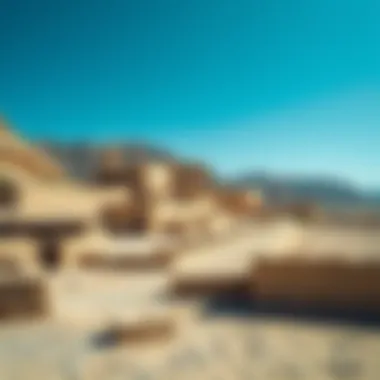

Cultural Background
The cultural tapestry surrounding Wadi Habb is as rich as the land itself. It has been a focal point for ancient civilizations that once thrived in this arid landscape. Local legend and history provide a narrative that enliven the region, beginning from early nomadic tribes who knew how to thrive in what might seem a harsh environment to many. They often relied on the rare water sources and vegetation found in the wadi.
In addition to its historical significance, local communities today continue to engage with their heritage, featuring traditional crafts and storytelling that connect the past with present lifestyles. Acknowledging these cultural dimensions is essential for investors looking to develop properties in the area. Grounding new projects within the context of local history can lead to more sustainable and accepted developments, ensuring that both residents and visitors can appreciate the blend of history and modernity found in Wadi Habb.
"Every rock and bush here tells a story, and it is through understanding these narratives that one can appreciate the full beauty of Wadi Habb."
Ecological Aspects of Wadi Habb
The ecological aspects of Wadi Habb play a pivotal role in understanding its overall significance. This region, rich in natural beauty, showcases not only its landscapes but also a variety of plant and animal life that demand attention. The balance of these ecosystems contributes to both environmental health and cultural heritage, creating an intricate relationship between nature and humanity.
Biodiversity in the Wadi
Biodiversity within Wadi Habb is remarkable. Species ranging from flourishing vegetation to unique wildlife thrive in its diverse habitats. The valley is home to numerous endemic plants, many of which have adapted to the arid climate, showcasing nature's resilience.
"The complexities of biodiversity are not merely academic; they represent the lifeblood of ecosystems that support local communities and economies."
Some notable aspects of the biodiversity include:
- Flora: The landscape is dotted with date palms, shrubs, and various herbs that hold medicinal properties. Here, one can find the resilient Ghaf tree, symbolizing endurance in the desert.
- Fauna: The fauna ranges from small mammals like the desert fox to a plethora of bird species, which makes Wadi Habb a hotspot for ornithologists. Certain migratory birds stop here, relying on the valley’s resources.
- Aquatic Life: The presence of ephemeral streams within the Wadi leads to a specific composition of aquatic life that aligns with seasonal rains.
In essence, understanding the biodiversity within Wadi Habb can help real estate investors grasp the allure this area has for potential homebuyers seeking proximity to nature. Preservation efforts also highlight a broader trend in sustainable housing initiatives.
Environmental Challenges
Despite its ecological richness, Wadi Habb encounters several environmental challenges that jeopardize its delicate balance. Urban expansion, which could lure potential investors, poses threats to the natural ecosystem. The potential clash between development and conservation illustrates a pressing concern.
Some key challenges include:
- Water Scarcity: The over-extraction of water resources for both agricultural and residential use strains the already limited water supply. This leads to diminishing water quality and availability.
- Pollution: Increased tourism and nearby industrial activities introduce pollutants to the ecosystem. Waste management becomes a critical issue, potentially harming wildlife and plant life.
- Climate Change: Changes in climate patterns are also affecting the Wadi's habitats, with shifting temperatures impacting species' survival.
Yet, recognizing these challenges isn't solely about identifying problems. It's a clarion call for investors and developers to engage in sustainable practices that will not only mitigate risks but also enhance community and ecological health. By integrating environmental considerations into development plans, stakeholders can ensure that Wadi Habb remains a treasure for generations to come.
In summary, Wadi Habb's ecological significance is multi-layered, appealing to various audiences, from nature enthusiasts to potential investors. Incorporating an eco-conscious approach into development initiatives ensures that real estate can flourish alongside natural ecosystems.
Historical Exploration of Wadi Habb
The historical context of Wadi Habb is much like a tapestry, woven from the threads of various civilizations that have inhabited this region over centuries. Understanding this history is crucial not only for appreciating the very fabric of the area but also for investors and homebuyers looking to forge a connection with this unique landscape. Delving into the past, Wadi Habb reveals layers of culture and development that greatly inform its present and future potential.
Ancient Civilizations and Settlements
Wadi Habb, nestled in the heart of the UAE, has served as a crossroads for myriad ancient civilizations. The rich history can be traced back to as early as the Bronze Age when nomadic tribes roamed the area, drawn to the lush resources the wadi provided. Evidence suggests that these people relied heavily on the natural springs which nourished both flora and fauna, supporting their way of life.
Moreover, as trade routes expanded, Wadi Habb became an essential point for exchanging goods. Artifacts discovered in nearby regions, including pottery and tools, hint at the vibrant exchanges that took place. For instance, ancient texts from Babylonia reference trade missions to settlements near Wadi Habb, showcasing the area's connections to wider historical narratives, which could make it appealing to buyers looking for properties imbued with history.
- Key Features of Ancient Settlements:
- Evidence of irrigation systems used for agriculture
- Remnants of early dwellings and trading posts
- Unique petroglyphs that offer insight into the lifestyle of the time
Archaeological Discoveries
Archaeology in Wadi Habb has unveiled a treasure trove of discoveries that paint a vivid picture of life in ancient times. This landscape is not just a mere geographical feature; it's a living archive. The ongoing excavations have led to significant finds, including ancient relics and structural remnants that underscore the area's long-standing importance.
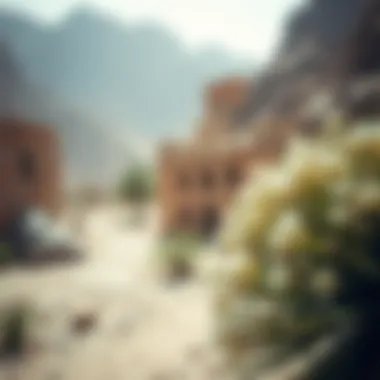

Among the most notable archaeological excavations are:
- The Great Shrine: An ancient temple site believed to have been dedicated to local deities, offering some context about the spiritual and cultural practices of the settlers.
- Burial Sites: These sites, often containing pottery and tools, provide insights into burial traditions and social hierarchies among the population.
"Every stone turned, every artifact recovered, adds to the rich mosaic of Wadi Habb's history."
Understanding these archaeological findings helps form a more rounded view of the Wadi's significance. Investors may find appealing value propositions not just in the land but in the stories it holds. As the wadi continues to gain recognition, the prospect of future discoveries adds an air of excitement, further captivating potential buyers, developers, and cultural historians alike.
For those interested in the region’s history, more information on archaeological efforts can be found at Wikipedia and Britannica.
Through these lenses—ancient civilizations and archaeological discoveries—Wadi Habb emerges as a site steeped in relevance, symbolizing a confluence of history, culture, and economic opportunity.
Tourism Potential of Wadi Habb
The tourism potential of Wadi Habb serves as a linchpin in understanding its role within the broader context of the UAE’s cultural and ecological landscapes. With its unique geographical features and cultural depth, Wadi Habb is more than just a picturesque location; it is an emerging hotspot for visitors seeking an authentic experience intertwined with adventure and tranquility. The incorporation of tourism into local development plans can bolster economic growth, create job opportunities, and enhance community engagement in conservation efforts. Additionally, its accessibility to urban centers further amplifies its potential as a tourist destination, making it appealing not only for local adventurers but also for international tourists.
Attractions for Visitors
Wadi Habb boasts a myriad of attractions that cater to various interests — from those who seek thrilling adventures to visitors who prefer a more relaxed exploration of nature. Here’s a closer look at some standout features:
- Hiking Trails: Wadi Habb is enveloped by rugged terrains, offering a range of hiking trails suitable for different skill levels. Trails like the Al Hajar Mountains path lead wanderers through stunning vistas, showcasing unique flora and fauna that add charm to the rugged landscape.
- Cultural Tours: Engaging with local culture is highly valuable here. Visitors may find guided tours that explore ancient petroglyphs and historical settlements. Such experiences allow tourists to connect deeply with the heritage of the area, creating lasting impressions.
- Diverse Wildlife Spotting: Bird watchers and nature enthusiasts will appreciate the distinct wildlife residing in Wadi Habb. Seasonal migrations make this place a prime spot for observing various species of birds, alongside endemic wildlife that flourishes in the region.
- Adventure Sports: From rock climbing to canyoning, the rugged geography presents a thrilling playground for adventure seekers. Local operators often facilitate experiences that cater to both beginners and those with more experience.
- Scenic Picnic Spots: For families and relaxed visitors, there are secluded areas ideal for picnics. The serene ambiance allows for a peaceful retreat amidst nature, perfect to unwind while enjoying the landscape's allure.
Each of these attractions not only adds to the visitor experience but also establishes Wadi Habb as a versatile destination, ready to accommodate diverse interests.
Impact on Local Economy
The implications of enhancing tourism in Wadi Habb extend beyond mere income generation; they have the potential to reshape the regional economy. As tourism increases, the positive ripple effects span various sectors:
- Job Creation: The influx of tourists necessitates services like hospitality, guiding, and maintenance, fostering new job opportunities for local residents. This development can improve livelihoods while maintaining a connection to the land.
- Support for Local Businesses: Increased visitation translates to higher demand for local products and services, from artisanal crafts to traditional cuisines. Encouraging tourists to engage with local markets supports smaller enterprises and promotes cultural exchange.
- Investment in Infrastructure: A thriving tourism sector can stimulate investments in infrastructure, such as roads, sanitation, and communications. Improvements benefit not only tourists but also residents, enhancing their quality of life.
- Revenue for Conservation: An increase in tourism typically generates funds through entry fees and licenses, which can be channeled into conservation efforts. This funding is crucial for maintaining the ecological and cultural integrity of Wadi Habb.
Whether it’s a family looking for a weekend getaway or an adventurer seeking thrills, the development of tourism in Wadi Habb can present a nexus of economic opportunity and community enhancement. Balancing growth with sustainability is critical, ensuring Wadi Habb remains a treasure for present and future generations.
"Understanding the local environment and engaging the community is key to unlocking the true tourism potential of Wadi Habb."
For further insights, you might explore resources such as Wikipedia and cultural articles on Britannica.
Real Estate Development Around Wadi Habb
The growth of real estate development in the vicinity of Wadi Habb is a significant aspect of the area’s transformation, both economically and socially. As urban centers expand and the demand for residential properties and commercial spaces intensifies, Wadi Habb presents unique opportunities and challenges for developers and investors alike.
Current Market Trends
In recent years, the trajectory of the real estate market around Wadi Habb has been nothing short of dynamic. Notably, there’s been a surge in interest from both investors and homebuyers seeking properties that promise not just a roof over their heads but a lifestyle deeply integrated with nature. With the UAE’s emphasis on sustainability and developing green living spaces, properties near Wadi Habb often witness rapid appreciation.
- Accessibility: Improved transportation links to major cities like Abu Dhabi and Dubai have augmented the attractiveness of the area.
- Eco-friendliness: Increasing awareness around environmental issues has led many to seek homes that harmonize with natural landscapes. The integration of eco-friendly building materials and designs is becoming standard.
- Luxury Developments: High-end residential units are cropping up, targeting affluent buyers looking for exclusivity amid beautiful scenery.
By keeping an eye on these burgeoning trends, stakeholders can strategize effectively to capitalize on the ever-evolving market.
Investment Opportunities
Investors looking toward Wadi Habb will find numerous avenues to explore. The potential for new developments, coupled with the economic growth in the UAE, offers a fertile ground for various types of investments.
Here are some key areas of interest:
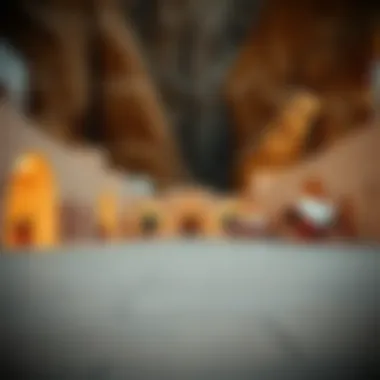

- Residential Projects: With an increasing population, the demand for affordable and luxury housing is on the rise. The market is ripe for developers who can offer innovative housing solutions that consider both price and sustainability.
- Commercial Ventures: The growing influx of tourists and residents paves the way for retail and hospitality initiatives. Restaurants, cafes, and resorts aligned with the natural beauty of the Wadi can yield profitable returns.
- Land Opportunities: Investing in land parcels today could pay off handsomely in the future as urban expansion continues.
"Wadi Habb is on the brink of transformation; wise investments today can bring fruitful returns down the line."
For additional resources on real estate trends, you may check Investopedia or explore community insights on Reddit.
For continued updates on market conditions, government reports can be accessed at UAE Government.
Developers, investors, and future homeowners must remain informed and adapt to these shifting sands to ensure successful ventures in Wadi Habb.
Community Involvement in Wadi Habb
Community involvement is a cornerstone of sustainable development in Wadi Habb. Engaging local communities in decision-making processes ensures that development aligns with the needs and desires of those who inhabit the area. This section explores the vital role of local initiatives and modern engagement strategies that not only protect the ecological character of Wadi Habb but also enhance the quality of life for its residents.
Local Initiatives for Conservation
The community in Wadi Habb has taken significant steps towards conservation. Local initiatives often focus on preserving the unique biodiversity and natural landscapes of the region. For instance, community-led clean-up events play a crucial role in maintaining the area's beauty while fostering a sense of ownership among residents.
Some of the notable initiatives include:
- Tree Planting Drives: Encouraging residents, including children, to participate in planting native tree species, which help in restoring natural habitats.
- Wildlife Monitoring Programs: By involving local volunteers in wildlife observation, communities can gather valuable data while raising environmental awareness.
- Education Workshops: These workshops aim to teach residents about the ecological significance of their surroundings, promoting a culture of conservation.
Such initiatives not only protect the environment but also create bonds within the community. By coming together for a common cause, residents feel a stronger connection to their land and each other.
"Involving the community is not merely beneficial; it’s essential for lasting change and meaningful stewardship of Wadi Habb’s natural resources."
Engagement with Modern Development
As Wadi Habb experiences growth and modernization, community engagement becomes increasingly important. Balancing development with local needs requires open communication and collaboration. Typically, community forums serve as platforms where residents can voice their concerns and contribute to planning discussions.
The engagement strategies include:
- Regular Town Hall Meetings: These provide opportunities for residents to directly interact with developers and local authorities.
- Feedback Surveys: Gathering input helps gauge public sentiment about new projects and adjustments needed to existing plans.
- Partnerships with Local Businesses: Encouraging sustainable practices within businesses can lead to economic growth that aligns with community conservation goals.
Overall, the approach to modern development in Wadi Habb recognizes the importance of community voices. As investments flow into the region, listening to the local populace ensures that growth is equitable and reflective of the values that define Wadi Habb.
Ending and Future Perspectives
As we wrap up our exploration of Wadi Habb, it becomes clear that understanding this locale is not just a scholarly pursuit. The insights gathered through the article highlight the intricate balance between development and conservation; each thread weaves together the historical legacies, cultural riches, and potentials for sustainable real estate advancement. Investors, homebuyers, and community stakeholders are all poised at a pivotal intersection where knowledge can lead to impactful decisions.
Sustainable Development Practices
Sustainable development practices are more than just buzzwords in today’s world; they serve as a crucial framework to ensure that progress does not come at the expense of our environment or cultural heritage. Wadi Habb presents unique challenges and opportunities for such practices. Here are some key components of sustainable development in relation to this area:
- Ecological Awareness: Development initiatives must prioritize ecological impacts. Preserving the natural biodiversity of Wadi Habb can enhance both tourism and community well-being.
- Local Materials and Techniques: Utilizing locally sourced materials not only reduces the carbon footprint but also aligns developments with the region’s aesthetic and cultural character.
- Community Involvement: Engaging local communities in the planning and implementation of development projects increases acceptance and ensures that local needs are met.
By integrating these practices, future projects in Wadi Habb can thrive without sacrificing the essence of this beautiful landscape.
Vision for Wadi Habb
Looking ahead, the vision for Wadi Habb should be one that embraces both innovation and tradition. A harmonious blend of modern urbanization with the respect for nature and heritage can set a precedent for similar regions. Key aspects of this vision should include:
- Smart Urban Planning: Using advanced technologies to create efficient and livable spaces that are eco-friendly.
- Cultural Heritage Preservation: Ensuring that any new developments honor and reflect the rich history of the area while also providing spaces for cultural expression.
- Tourism Enhancement: Developing infrastructures like eco-friendly lodgings and guided tours that offer insight into the natural and historical significance of Wadi Habb.
"The direction in which education starts a man will determine his future in life." - Plato
For more information about sustainable practices and real estate developments, you may visit relevant articles on Wikipedia or explore Britannica's insights.
Understanding and addressing the future perspectives of Wadi Habb is crucial as it allows us to navigate the complex interplay of nature, culture, and urban growth. It’s an exciting time, and the path ahead is ripe with opportunities.






